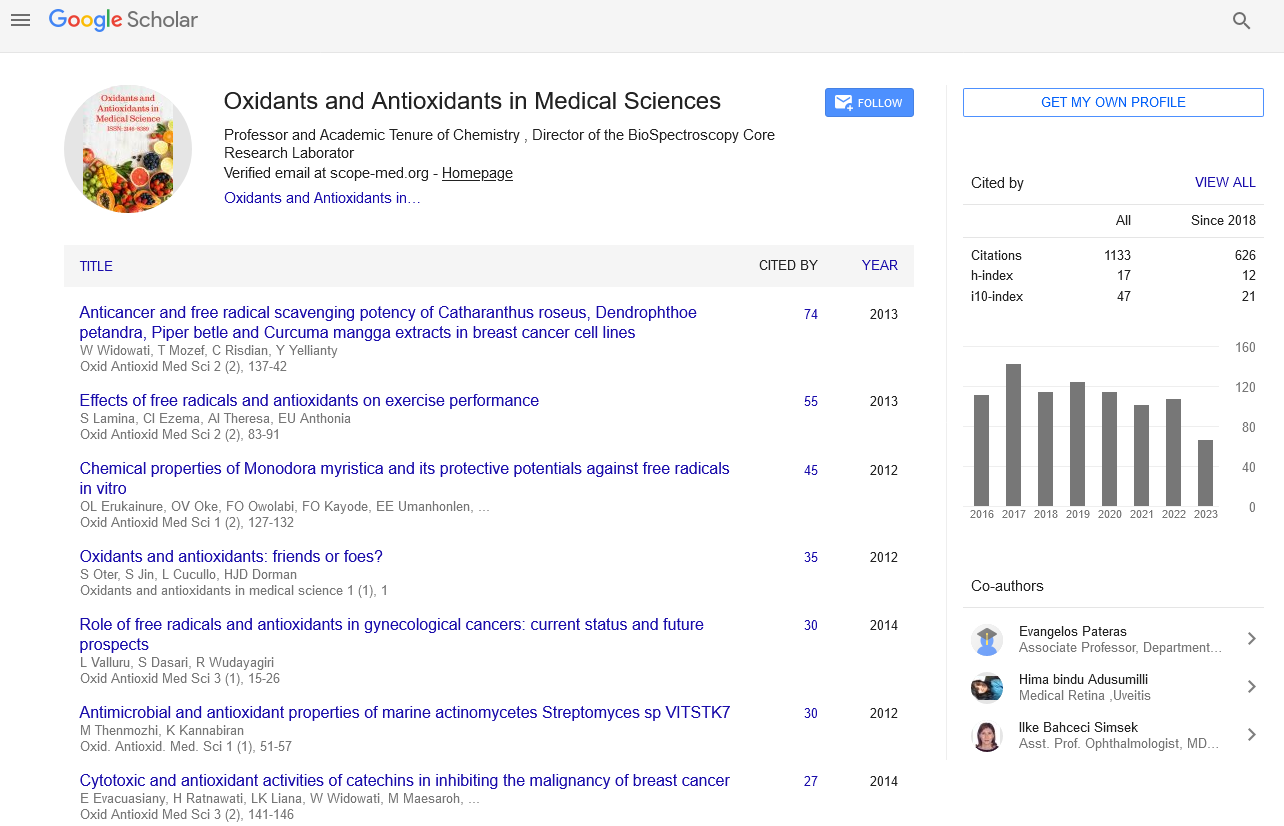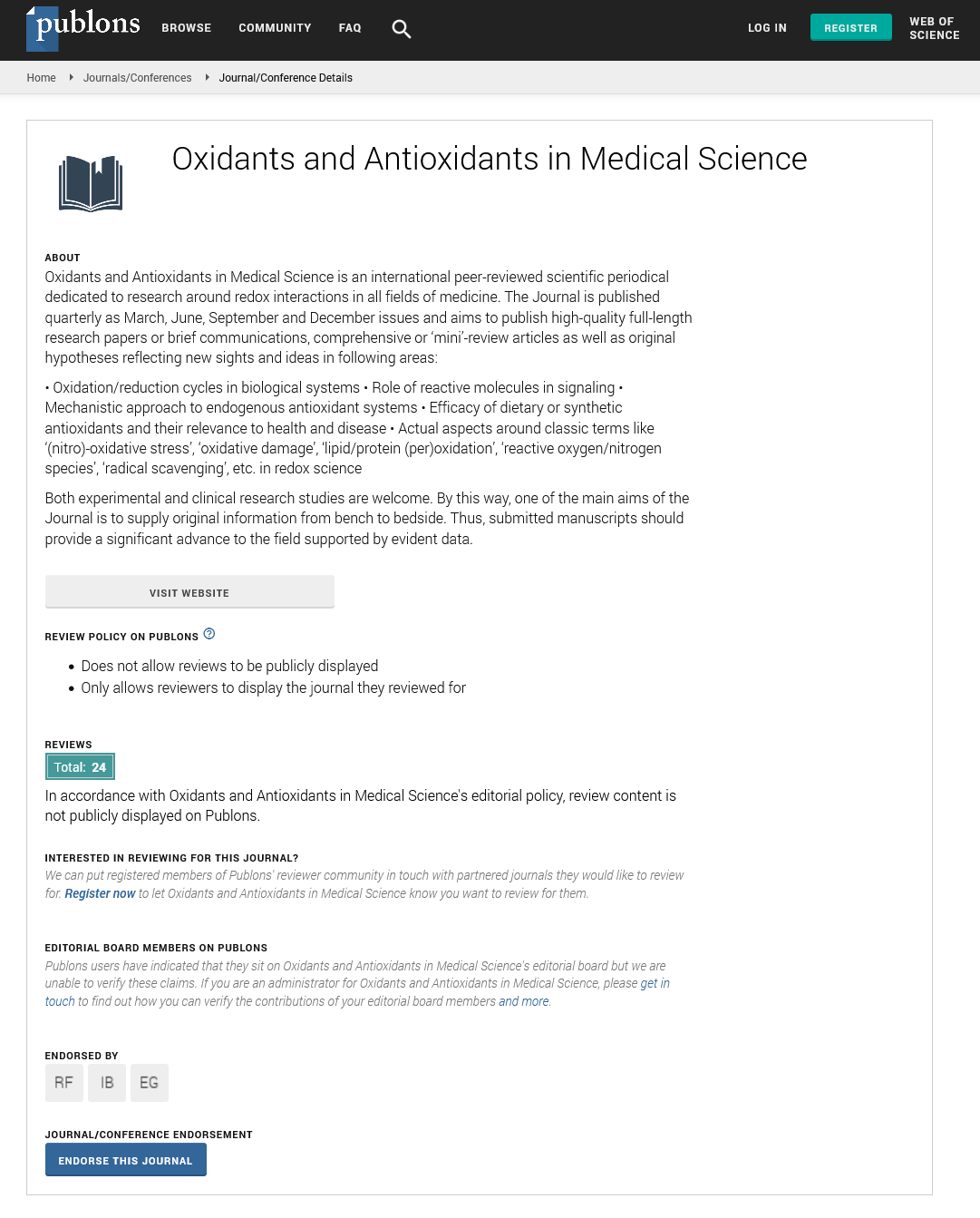Short Communication - Oxidants and Antioxidants in Medical Science (2024)
The Role of Flavonoids and its Mechanisms to improve Obesity and Metabolic Health
Erica Swietlik*Erica Swietlik, Department of Nutrition, University of Wisconsin, Madison, USA, Email: Ericaswietlik@wisc.edu
Received: 22-Apr-2024, Manuscript No. EJMOAMS-24-139309; Editor assigned: 24-Apr-2024, Pre QC No. EJMOAMS-24-139309 (PQ); Reviewed: 08-May-2024, QC No. EJMOAMS-24-139309; Revised: 15-May-2024, Manuscript No. EJMOAMS-24-139309 (R); Published: 22-May-2024
Description
Obesity is a significant global health challenge, contributing to various chronic diseases such as type 2 diabetes, cardiovascular diseases, and certain cancers. The multifactorial etiology of obesity includes genetic, environmental, and lifestyle factors, making its management complex. Recently, the role of dietary components, particularly flavonoids, has gained attention for their potential in preventing and managing obesity.
Flavonoids
Flavonoids are a diverse group of phytonutrients found in almost all fruits, vegetables, grains, and certain beverages like tea and wine. They are known for their antioxidant, anti-inflammatory, and anticarcinogenic properties. Structurally, flavonoids are characterized by a 15carbon skeleton, consisting of two phenyl rings and a heterocyclic ring. They are subdivided into several classes, including flavones, flavonols, flavanones, flavanols (catechins), isoflavones, and anthocyanins [1].
Mechanisms of flavonoids in preventing obesity
Modulation of energy balance: Flavonoids influence both energy intake and expenditure. Some flavonoids, such as catechins found in green tea, enhance thermogenesis and fat oxidation. By increasing the basal metabolic rate, they help in burning more calories even at rest [2]. Additionally, flavonoids can reduce appetite and food intake by regulating appetite related hormones like ghrelin and leptin [3].
Inhibition of adipogenesis: Adipogenesis is the process of cell differentiation by which preadipocytes become mature adipocytes, contributing to fat mass [4]. Flavonoids like quercetin and kaempferol inhibit adipogenesis by downregulating the expression of key adipogenic genes and transcription factors, such as PPARγ (Peroxisome Proliferator activated Receptor Gamma) and C/EBPα (CCAAT/enhancerbinding protein alpha).
Enhancement of lipolysis: Flavonoids promote the breakdown of fats (lipolysis) in adipose tissue. For instance, naringenin, a flavonoid found in citrus fruits, activates Ampactivated Protein Kinase (AMPK), a critical enzyme in cellular energy homeostasis that enhances lipolysis and fatty acid oxidation [5].
Antiinflammatory effects: Chronic low grade inflammation is a Attribute of obesity and metabolic syndrome. Flavonoids exhibit strong antiinflammatory properties by inhibiting the production of proinflammatory cytokines like TNFα, IL6, and CRP. By mitigating inflammation, flavonoids help improve insulin sensitivity and reduce the risk of obesity related complications [6].
Modulation of gut microbiota: Emerging evidence suggests that flavonoids can positively alter the composition and function of gut microbiota. A healthy gut microbiota is essential for maintaining metabolic health [7]. Flavonoids increase the abundance of beneficial bacteria such as Bifidobacteria and Lactobacilli while reducing harmful bacteria. This modulation of gut microbiota contributes to improved metabolic outcomes, including reduced fat accumulation and enhanced glucose metabolism [8].
Improvement of insulin sensitivity: Insulin resistance is a common feature of obesity. Flavonoids like anthocyanins and flavanols improve insulin sensitivity by enhancing insulin signaling pathways and glucose uptake in muscle and adipose tissues [9]. This helps in maintaining normal blood glucose levels and preventing excessive fat storage [10].
Dietary sources and recommendations
Incorporating flavonoid rich foods into the diet is a practical approach to harnessing their antiobesity benefits. Some of the best sources include:
Fruits: Apples, berries (blueberries, strawberries, blackberries), citrus fruits (oranges, grapefruits, lemons).
Vegetables: Onions, kale, broccoli, spinach.
Beverages: Green tea, black tea, red wine.
Others: Dark chocolate, nuts, seeds.
For optimal benefits, it is recommended to consume a variety of these foods regularly as part of a balanced diet. The synergy of different flavonoids and other phytonutrients can enhance their overall efficacy. Flavonoids represent a potential natural strategy in the fight against obesity. Through multiple mechanisms, including modulation of energy balance, inhibition of adipogenesis, enhancement of lipolysis, antiinflammatory effects, modulation of gut microbiota, and improvement of insulin sensitivity, flavonoids can play a important role in preventing and managing obesity. Future research and clinical trials will further elucidate their potential and prepare for dietary guidelines incorporating flavonoid rich foods for obesity prevention and overall health improvement.
References
- Stein J, Stier C, Raab H, Weiner R. The nutritional and pharmacological consequences of obesity surgery. Aliment Pharmacol Ther 2014; 40(6):582-609.
[Crossref] [Google Scholar] [PubMed]
- Oliveira AK, de Oliveira e Silva AM, Pereira RO, Santos AS, Barbosa Junior EV, Bezerra MT, et al. Anti-obesity properties and mechanism of action of flavonoids: A review. Crit Rev Food Sci Nutr 2022;62(28):7827-7848.
[Crossref] [Google Scholar] [PubMed]
- Bielecka J, Markiewicz-Żukowska R, Nowakowski P, Puścion-Jakubik A, Grabia M, Mielech A, et al. Identifying the food sources of selected minerals for the adult European population among rice and rice products. Foods 2021;10(6):1251.
[Crossref] [Google Scholar] [PubMed]
- Aleksandrova K, Koelman L, Rodrigues CE. Dietary patterns and biomarkers of oxidative stress and inflammation: A systematic review of observational and intervention studies. Redox Biol 2021; 42:101869.
[Crossref] [Google Scholar] [PubMed]
- Burton-Freeman B, Linares A, Hyson D, Kappagoda T. Strawberry modulates LDL oxidation and postprandial lipemia in response to high-fat meal in overweight hyperlipidemic men and women. J Am Coll Nutr 2010;29(1):46-54.
[Crossref] [Google Scholar] [PubMed]
- Kim HJ, Seo JY, Suh HJ, Lim SS, Kim JS. Antioxidant activities of licorice-derived prenylflavonoids. Nutr Res Pract 2012;6(6):491.
[Crossref] [Google Scholar] [PubMed]
- Sabatini SE, Juarez AB, Eppis MR, Bianchi L, Luquet CM, de Molina MD. Oxidative stress and antioxidant defenses in two green microalgae exposed to copper. Ecotoxicol Environ Saf 2009;72(4):1200-1206.
[Crossref] [Google Scholar] [PubMed]
- Choi JW, Park GH, Choi HJ, Lee JW, Kwon HY, Choi MY, et al. Anti‑obesity and immunostimulatory activity of Chrysosplenium flagelliferum in mouse preadipocytes 3T3‑L1 cells and mouse macrophage RAW264. 7 cells. Exp Ther Med 2024;28(2):1-3.
[Crossref] [Google Scholar] [Pubmed]
- Youn I, Piao D, Park J, Ock SA, Han S, Han AR, et al. Anti-Obesity Activities of the Compounds from Perilla frutescens var. acuta and Chemical Profiling of the Extract. Molecules 2024;29(11):2465.
[Crossref] [Google Scholar] [Pubmed]
- Lee HY, Cho DY, Jeong JB, Lee JH, Lee GY, Jang MY, et al. Chemical compositions before and after lactic acid fermentation of isoflavone-enriched soybean leaves and their anti-obesity and gut microbiota distribution effects. Nutrients 2024;16(11):1693.







